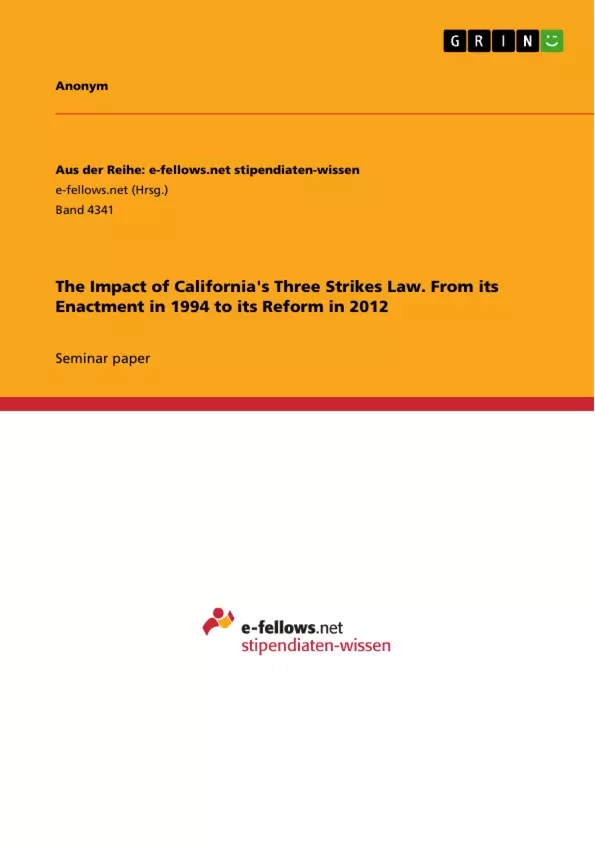This paper examines the consequences of both the original TSL and its reform, focusing on the key question of to what degree the reform was able to rectify the flaws of the initial ruling. To achieve this, the first part of the paper describes the context in which the law was initially developed and enacted. Subsequently, the original application in the second and third cases is explained before outlining the alterations introduced by the Reform Act in 2012.
The paper will discuss the original TSL, concentrating on four major points of criticism. First, the effectivity of the law in reducing high crime rates in CA and the accuracy of the implementation of the voters will. Furthermore, the life-changing consequences for the convicts and their families and the enormous economic costs for the state’s justice and prison system associated with the higher number of people serving lengthy prison sentences. The paper will end with a conclusion that summarizes the key points and answers the key question.
The genesis and passage of California’s so-called "Three Strikes Law" (TSL) occurred against the backdrop of the highest crime rate in the state’s history. However, it was two homicides of young American girls that shocked the Californian people, sparking a public outcry and compelling lawmakers to finally take more decisive measures. The result was the enactment of California’s Three Strikes Law in 1994, which was neither the first nor the only such law but by far the strictest in the entire nation.
Its enactment, marking the most significant change to the Californian criminal justice system in more than a generation, aimed to better protect the public from habitual criminals who commit violent and other serious felonies. The new law would have sentenced them to prison for 25 years to life. However, it also led to the lengthy incarceration of many non-violent second and third strikers, prompting criticism of disproportionately harsh punishment. After several unsuccessful attempts, the "Three Strikes Reform Act" (TSRA) was passed in 2012, significantly reforming the TSL by restricting its application to repeat serious and violent offenders, aligning with the original intention of Californian voters and lawmakers.
Inhaltsverzeichnis (Table of Contents)
- Introduction
- Background
- Genesis & Passing of the Californian Three Strikes Law in 1994
- Rules within the Framework of the Californian Three Strikes Law
- Ruling for Second Strike Cases
- Ruling for Third Strike Cases
- Reform of the Three Strikes Law in 2012
- Analysis
- Criticism of the Californian Three Strikes Law of 1994
- Effectivity
- Intention of Californian Voters
- Consequences for Convicts
- Economic Consequences
- Addressing Criticism by the Californian Three Strikes Reform Act of 2012
Zielsetzung und Themenschwerpunkte (Objectives and Key Themes)
This paper aims to examine the consequences of California's "Three Strikes Law" (TSL) and its subsequent reform, focusing on the degree to which the reform rectified the flaws of the original ruling. The paper explores the historical context of the TSL's implementation and the rationale behind its creation. Additionally, it analyzes the application of the law in both its original form and after the 2012 reform, highlighting the impact on second and third strike convictions.
- The genesis and passage of the Californian Three Strikes Law in 1994
- The application of the Three Strikes Law in second and third strike cases
- The effectiveness of the Three Strikes Law in reducing crime rates
- The unintended consequences of the Three Strikes Law for convicts, their families, and the state's justice system
- The impact of the Three Strikes Reform Act of 2012 on the original law's application and effectiveness
Zusammenfassung der Kapitel (Chapter Summaries)
The first chapter provides a comprehensive background on the genesis and passage of the Californian Three Strikes Law in 1994. It explores the rise in crime rates during the 1980s and early 1990s, the public outcry following the murders of Kimber Reynolds and Polly Klaas, and the eventual enactment of the law. The chapter concludes by outlining the key provisions of the TSL, including the sentencing guidelines for second and third strike convictions.
The second chapter delves into the application of the TSL in second and third strike cases. It explains the specific sentencing rules and their impact on individuals convicted of multiple felonies. The chapter also highlights the varying implementation of the law across different counties in California and discusses the unique characteristics of the Californian TSL compared to similar legislation in other states.
The third chapter focuses on the reform of the Three Strikes Law in 2012. It examines the criticism leveled against the original law, including its effectiveness in reducing crime rates, the unintended consequences for convicts and their families, and the economic burden it imposed on the state's justice system. The chapter concludes by outlining the key provisions of the Three Strikes Reform Act of 2012 and its impact on the original TSL.
Schlüsselwörter (Keywords)
The key terms and concepts explored in this paper include the Californian Three Strikes Law, repeat offenders, violent and non-violent felonies, sentencing guidelines, recidivism, public safety, criminal justice reform, and the Three Strikes Reform Act of 2012. The paper analyzes the effectiveness of the Three Strikes Law in reducing crime rates, the impact on convicts and their families, and the economic consequences for the state's justice system.
- Quote paper
- Anonym (Author), 2023, The Impact of California's Three Strikes Law. From its Enactment in 1994 to its Reform in 2012, Munich, GRIN Verlag, https://www.grin.com/document/1448902



